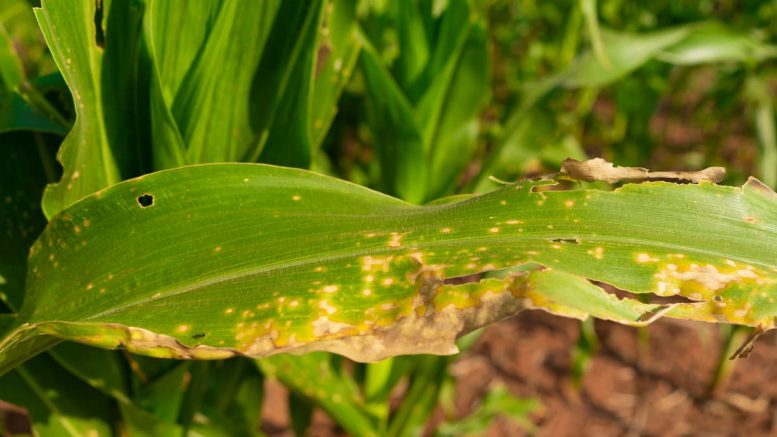“From corn emergence to phenological stage V8, this is considered the Critical Control Period and full attention should be paid…”
Paulo Garollo is a crop science researcher associated with Fitolab, a specialist in corn cultivation, with a degree in agricultural engineering from the Luíz Meneghel Faculty of Agronomy.

Paulo Garollo, crop science researcher associated with Fitolab
AgriBrasilis – Why is it so difficult to control the corn leafhopper (Dalbulus maidis)?
Paulo Garollo – The main factors are:
– “Green bridges” – the continuous planting of corn crops throughout the year in several states of Brazil, the lack of control of volunteer corn (“weed corn”), grain losses during transportation and the random maintenance of corn plants, are factors that allow the maintenance and multiplication of populations of leafhoppers, as well as the causal agents of stunting – mollicutes (Spiroplasma and Phytoplasma) and the viruses MSMV and MRFV – which are obligatory parasites;
– Migratory potential of the pest – the leafhopper is an insect with a migration habit that encompasses large distances, from 10 to 20 km in radius (natural flight) and can travel distances exceeding 100 km when in wind currents, providing a high potential for dispersal;
– Abaxial position (below) of the nymphs on the corn leaves – this factor hinders the efficiency of contact products in killing the nymphs;
– Lack of strategy in the use of chemical and biological pesticides – use without developing a robust strategy for choosing products, without taking into account the ecobiology of the pest, the characteristics of the chemical products, the appropriate time for application, the phenological stages of the plant and the environment at the time of application, are all factors that can seriously compromise the efficiency of the management adopted;
– Genetic materials with “resistance” to the causal agents – there are still few options for maintaining the productive potential of corn;
– Staggering of crop planting;
These are factors that play a very relevant role in the difficulty of achieving high efficiency in pest management.
Losses may exceed 70% of the crop’s productive potential, considering direct damage. However, we can still increase the percentage of damage, if we consider secondary and/or additional damage, such as the greater ease of contamination in “sick” plants by other agents that cause diseases, as in the case of fungi that cause stalk rot, for example.
“If there are leafhoppers in the crop, regardless of the number, pesticide applications should be started”
AgriBrasilis – Why is reducing the nymph population considered strategic and how is it possible to achieve this control?
Paulo Garollo – Nymph control, which has not been the focus of management practices adopted so far, could and should be one of the management actions that breaks the pest cycle, becoming an alternative that could contain and even reduce the population growth of the corn leafhopper.
The main control methods are supported by the use of chemical insecticides associated with biological insecticides – entomopathogenic fungi and bacteria and growth-inhibiting insecticides; the use of hybrids with greater tolerance to diseases and in the control and/or eradication of tiguera corn.
AgriBrasilis – When should control of this insect begin and why?
Paulo Garollo – Management should begin preventively. Elimination of leafhoppers, followed by seed treatment and after crop emergence, when the first leaves appear.
From corn emergence to phenological stage V8, this is considered the Critical Control Period and full attention should be paid to monitoring the insect and its continuity in the crop. The earlier contamination by the causative agents of the diseases of the enfezamento complex occurs, the greater the impact on crop yield.
The pest monitoring and the decision to apply pesticides should be based on the presence or absence of the insect. Therefore, if there are leafhoppers in the crop, regardless of the number, pesticide applications should be started.
AgriBrasilis – How can growth inhibitors help to “break the cycle” of the pest?
Paulo Garollo – Insecticides classified as growth inhibitors, especially buprofesin and bioactivated neem oil essence, are the two options that are being sold in Brazil and represent a strategy for breaking the pest cycle. Without a doubt, these alternatives, which will be used as a complement to management and should be associated with other chemicals, could significantly reduce the evolution of the pest population.
In addition to having a direct effect on nymphs, these products act on adult females, rendering them sterile, generating eggs without nymphs and reducing the number of ovipositions. Thus, in addition to being “nymphicides”, they also act on adults.
AgriBrasilis – You said that it is possible to “live with the leafhopper”. Is its eradication not feasible?
Paulo Garollo – “Eradicating” an insect in nature is very difficult and not recommended, as it could cause negative impacts on the ecosystem.
Therefore, living with the pest, and maintaining its management at population levels below the level of economic damage, is the most appropriate and sustainable way.
READ MORE:

